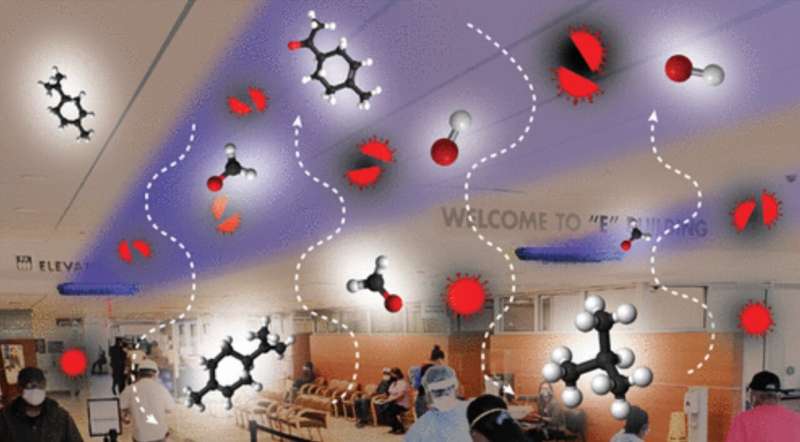
When winter chill strikes, people stay indoors more often, giving airborne pathogens—such as SARS-CoV-2 and influenza—prime opportunities to spread. Germicidal ultraviolet (GUV) lamps can help disinfect circulating air, but their UVC wavelengths could also transform airborne compounds into potentially harmful substances.
Now, researchers reporting in Environmental Science & Technology Letters have modeled the reactions initiated by UVC sanitizing light and find that there’s a trade-off between removing viruses and producing air pollutants.
Disinfecting UVC, also called germicidal UV, lamp systems have long been a cost-effective way to rapidly inactivate airborne pathogens indoors. One design uses lamps that shine at 254 nm, a wavelength that’s damaging to humans’ skin and eyes, requiring the devices to be mounted near the ceiling or inside ventilation ducts. Recently, light at 222 nm has been suggested for whole-room disinfection because the wavelength is reported to be safer for humans.
However, UVC light can set off many reactions. For example, this type of light is known to break apart molecules in the air, forming strong oxidants, such as hydroxyl radicals and ozone. Then these oxidants can convert volatile organic compounds (VOCs) already in the air into peroxides and carbonyl compounds, which can be further broken up by UVC light into organic radicals.
The strong oxidants and organic radicals are known to undergo secondary reactions to generate additional VOCs and particulate matter, some of which could negatively impact people’s health. But the levels of compounds potentially generated from these secondary reactions from GUV systems hadn’t been studied. So, Zhe Peng, Shelly Miller and Jose Jimenez wanted to use computer models to evaluate the possible impact that the two types of UVC air cleaning systems could have on disinfection and air quality in typical indoor conditions.
With computer simulations, the researchers estimated the SARS-CoV-2 virus removal rate and the amount of secondary VOCs that would be generated in three indoor scenarios in conjunction with different room ventilation rates. Initial results indicated that both UVC wavelengths would significantly decrease the risk of infection by SARS-CoV-2 compared to ventilation alone.
The models also projected that the systems would initiate secondary reactions with VOCs expected to be in indoor air. Although only small amounts of secondary VOCs, ozone and particulate matter would likely be produced, the estimated levels weren’t negligible.
Based on the results, the team recommends the use of GUV systems in environments at high risk of airborne pathogen transmission—those in which the benefit of removing these microbes outweighs the impact of the added air pollutants. The researchers point out, however, that this study’s findings are limited to the conditions chosen for the computer models, which could be different in real-world locations.
More information: Zhe Peng et al, Model Evaluation of Secondary Chemistry due to Disinfection of Indoor Air with Germicidal Ultraviolet Lamps, Environmental Science & Technology Letters (2022). DOI: 10.1021/acs.estlett.2c00599
Journal information: Environmental Science & Technology Letters
Provided by American Chemical Society


